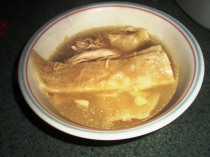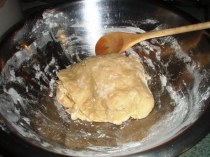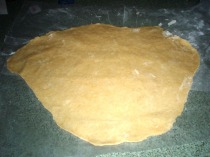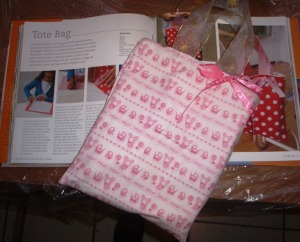I want to add a lot of good family recipes here, and I figured I’d start with my good basic chicken soup! This recipe (and the Chicken and Dumplings you can use it in…recipe to follow) has been in my husband’s family for about a hundred years, and when I wanted to learn to make it my mother-in-law said she’s teach me…after I bought a pressure cooker. A pressure cooker not only cooks chicken soup in about half the time of conventional cooking, it also locks in the flavor much better than boiling the chicken in a regular soup pot does.
Well, I’ve been through several pressure cookers in the past 15 years, and I would recommend buying a good one – not the Wal-Mart cheapies but something durable, like a Fagor or a Kuhn-Rikon. Some of the Presto pressure cookers are also good. As far as size goes, a 6-quart pressure cooker is just the right size for my family of five. Anyway…on to the recipe!
Making Pressure Cooker Chicken Soup
Chicken broth forms the base of many other soups and stews, so it’s useful to have a few containers of broth in the freezer – especially during cold and flu season!
To make a rich, golden chicken soup in a stove top pressure cooker, just follow these three easy steps:
Step 1: Cook the Chicken
To make the best chicken soup, choose either a pack of chicken breasts (bone-in) with very fatty skin or a quartered whole chicken. A 6-quart pressure cooker can easily fit two chickens inside, or two packs of breasts – so portions of the soup or broth can be frozen for future use.
Place the chicken in the pot and fill the pressure cooker with water to the maximum fill line. Put the lid on the pressure cooker and seal it. Heat the pot on medium-high until the pressure builds enough to make the pressure indicator jiggle or pop out (depending on the type of indicator), then turn the heat to low for 20 minutes for one chicken (or 1 package of breasts), or 30-40 minutes for two chickens. (Don’t worry – it’s hard to overcook it!)
Step 2: Cool the Broth and Separate the Chicken
Turn off the heat and let the cooker sit until the pressure drops enough on its own to open the pot, or run cold water on the lid to speed up the process. Once the soup has cooled enough to work with it, remove the chicken pieces with a slotted spoon or strainer.
At this point the cooked chicken can be used in another recipe – my kids love it in a simple dish with sliced kielbasa sausage, sauteed onions, white or basmati rice and olive oil. Or for chicken soup with the chicken in it, as opposed to broth alone, simply separate the meat from the bones and skin and add the meat back into the broth.
If any of the soup is to be frozen for future use, do it at this point before adding any vegetables, herbs or bouillon – so the soup will taste fresh even after the broth has been frozen. I also freeze a small, pint-sized amount of broth for use in sauces such as Chinese stir-fry recipes.
Step 3: Add Herbs, Vegetables and Spices
For a fragrant and flavorful soup, add some water and vegetables such as carrots, parsnips, garlic and onions (or no veggies at all), spices such as dill and parsley, and of course salt and pepper.
It’s also fine to add a chicken bouillon cube or a tablespoon or two of chicken soup mix, but the beauty of home-cooked chicken soup is that it doesn’t require artificial flavorings and colorings, loads of sodium or MSG. Usually, fresh herbs and veggies, salt, pepper, and maybe a dash of garlic powder and onion powder will do just as nicely.
So that’s it! All you need to make homemade chicken soup, and it doesn’t even take all day.




